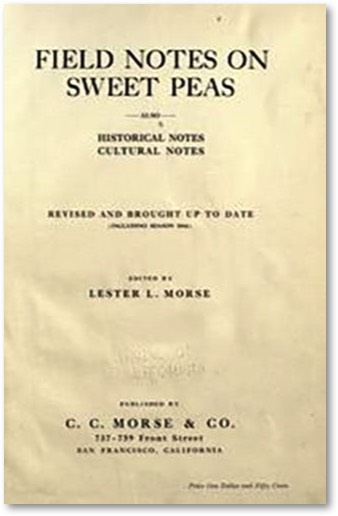
Musings » Field Notes on Sweet Peas


C.C. Morse and Co. 1917
The book I want to share with the club today is not in our library. It was lent to me by a renowned plant breeder, David Lemon, whose pelargoniums, marigolds and sweet peas all of us have grown at some time in our gardening careers. David is a charming Irishman who came to this country in the 1950s and rapidly prospered. As a youth he was beguiled by flowers and began an apprenticeship in Dublin. He was awarded a scholarship to study horticulture in the United States.
At different times David has bred plants for several large companies. Right now he is with Ecke Ranch, the firm which took over Oglevee about six months ago. Oglevee, based in Pennsylvania, solved the problem of pelargonium breeding en masse, among other things. The plants are always very susceptible to infections and keeping them germ-free was a huge accomplishment.
We all know Ecke Ranch without realizing it. They are the leaders in the poinsettia field, having bred the myriad colors and textures we now see every Christmas. When we stroll through the flower market in December we are overwhelmed by the choice in poinsettias, a plant which until the last few years came in uncompromising pillar-box red. Did any of us ever think about what was going on and how it happened?
Ecke probably did 90% of the work and sells about 90% of the plants. Paul Ecke saw that combining the strengths of their poinsettia (late autumn/winter) market with Oglevee’s spring and summer markets would create a blockbuster firm. The plant world has rapidly been undergoing this sort of consolidation just as airlines have merged and food producers have become enormous (eg Dart and Kraft). It just hasn’t hit the papers in the same way since economists do not focus on these non-essential “products”.
All North American plant producers are threatened by the same forces which have affected the manufacture of clothing, shoes and so forth. People in other countries are paid much less. With flowers, the climate is also a big factor. There used to be acres of greenhouses in the Bay area for roses. All of them have gone because it is just too expensive to heat the greenhouses. Why do you think that our commercial roses all hail from Ecuador or Costa Rica now?
Well now, you are saying to yourself, she has finally lost it. She starts with a book about sweet peas and is now ranting about globalization in the world of horticulture. There is a connection and we shall explore it. This small paper-bound book is dog-eared from long use. David Lemon received it from one of his mentors. Many fewer people grow sweet peas now than formerly.
There was a time when they were one of the most popular flowers around. Breeders knew that whatever they created would be snapped up eagerly in the market. A key discovery occurred in 1902 when the head gardener at the Spencer estate, Princess Diana’s family, found a totally different sweet pea among his rows of beautiful flowers. This flower was ruffled with huge petals and in an exquisite shade of pink. It was a sport, occurring spontaneously in nature. Mr Cole named it ‘Countess Spencer’. Thereafter two races of sweet peas co-existed, but the Spencer type was in the ascendant.
The result was that C. C. Morse in San Francisco could publish a list of 200 pages of sweet pea varieties as an appendix to his Field Notes on Sweet Peas for growers about fifteen years later. At a rough estimate the book lists about 1500 varieties. The author notes that some of them were already obsolete, no longer in production even at the time the book appeared. Breeding was equally rapid on both sides of the Atlantic.
It is this extraordinary range of choice, of diversity and variation, which gets lost when the industry is driven only by commercial goals. If a flower does not meet the market projections it is scrapped. Sweet peas are only one example.
I have to declare a conflict of interest. I have a granddaughter named Mabel Taylor. One of the lost sweet pea cultivars was the ‘Mabel Taylor’, bred by a Mr Sharpe.

